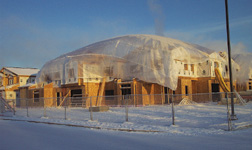One of Alaska’s biggest construction spenders over the past century continues to pour money into the Last Frontier. U.S. defense construction spending in the strategic state will reach $495 million this year, says a new University of Alaska-Anchorage report. Although the total is down from recent years, spending is strong by historic standards and is expected to stay robust as troop levels increase. “We have a very healthy schedule for the next few years,” says Randy Bowker, Army Corps of Engineers Alaska programs chief.
 Army Corps Of Engineers New approaches expedite work even in sub-arctic conditions, but there are still bumps.
|
The military will concentrate its Alaska dollars on housing, operations structures and runway upgrades, says the report. About $131 million will go toward infrastructure and facilities at Elmendorf Air Force Base, near Anchorage, which will house the next generation of fighter jets. The Grow-the-Army initiative will bring 1,300 new troops by 2013 to Fort Richardson in Anchorage and Fort Wainwright in Fairbanks. The Army is set to have almost 15,000 soldiers in Alaska within five years.
The Corps of Engineers’ use of private-sector practices to expedite needed facilities is showing signs of success, says Bowker. A $42-million, 67-unit housing project at Fort Wainwright was built in 447 days, down from the 820 typical for similar jobs in subarctic regions. It is the first of 15 housing projects in Alaska over the next five years. Phased construction now allows contractors to begin work after civil and foundation designs are complete. In the past, all design including mechanicals had to be approved before any construction could begin.
|
Privatization also is propelling projects. Actus Lend Lease, a Nashville-based unit of Bovis, recently announced it was in exclusive negotiations for a $420-million housing deal at Fort Wainwright and Fort Greely, near Delta Junction. Developments will include sustainable features such as community wind turbines.
But another initiative has hit a speed bump. Two Alaskan firms overturned the Corps district’s second use of a Multiple Award Task Order Contract (MATOC). The three-year contract, which “bundled” 35 construction projects worth $630 million into one, was designed to save money and time by streamlining task orders. Six winners were chosen, but last November the Government Accountability Office upheld two losing bidders who protested. The Corps said it would use traditional bidding methods in the near future consistent with GAO recommendations. Some construction observers such as Dean Clowers, senior vice president of Afognak Native Corp., Anchorage, believe the district will resurrect MATOC. “For the Corps, it’s one-stop shopping,” he says.
 Related Links:
Related Links: 
Post a comment to this article
Report Abusive Comment